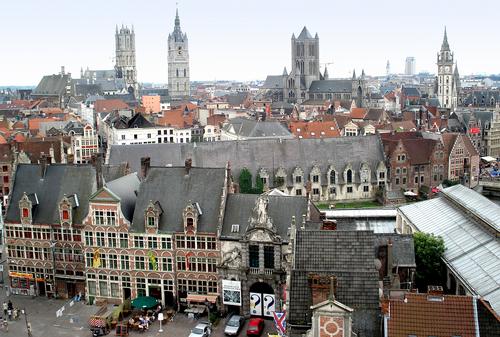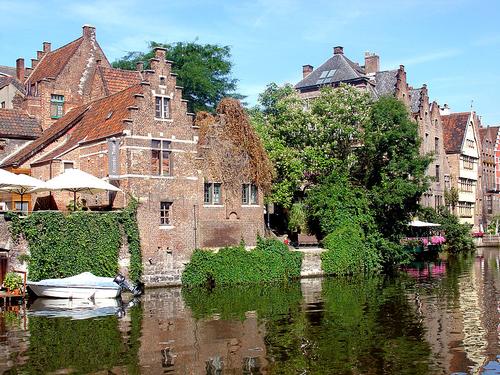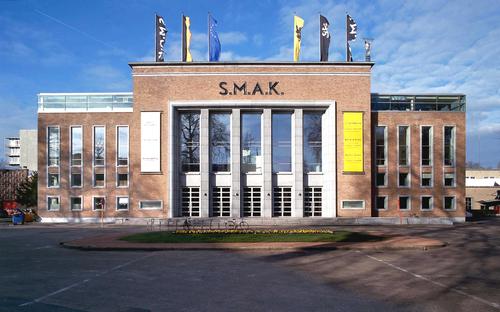BELGIUM
Ghent

Ghent
Ghent
 Ghent PanoramaPhoto:Public Domain
Ghent PanoramaPhoto:Public Domain
In the Middle Ages, Ghent was actually Europe's second largest city after Paris, and although Ghent is now somewhat overshadowed by the nearby capital of Brussels, the city is still a huge tourist draw at the confluence of the Scheldt and Lys. Ghent is the proud capital of East Flanders and although the city is considerably larger than Bruges, Ghent may not be as characterful and picturesque, but it is a real city.
Ghent has plenty of tourist appeal and the numerous students gives the city a young impression. This provides a well-groomed nightlife. Ghent does not have a central square, but has grown around a number of open spaces and historic churches. In principle, the Korenmarkt is the real heart of Ghent. The tourist office is located nearby under the Belfry.
Location
 Ghent on the LeiePhoto: Public Domain
Ghent on the LeiePhoto: Public Domain
Ghent has an area of 156.18 km² and has approximately 250,000 inhabitants. Many people are surprised by the size of Ghent, it is actually the largest city in this part of Flanders. Ghent is located around the crossroads of the river Leie and the Schelde. The city is connected to the sea by the Ghent-Terneuzen canal, which is a picturesque canal and perfect for an afternoon stroll.
Weather
Ghent is a city with a fairly stable climate. The weather in Ghent only changes slightly from month to month, which means that the main seasons merge gently and are often very difficult to distinguish. Ghent's winter climate is fairly mild and nighttime temperatures from December to February generally hover just above freezing. It starts to get warmer in March.
The city blossoms in the spring. It is attractive to visit Ghent in both April and May. Temperatures are generally around 15° C during the day and can reach as high as 20° C on the sunniest days, especially in May. Between June and August is perhaps the best time to enjoy the sights of Ghent. The weather is sunny and warm, and the Belgian beer flows exuberantly. July and August are the hottest months with regular temperatures above 25° C.
History
 Map of Ghent from 1534Photo: Public Domain
Map of Ghent from 1534Photo: Public Domain
Thanks to its location at the confluence of the Leie and the Scheldt, the history of the city started with regional trade and commerce from an early age. Like many other cities in this region of Europe, Ghent grew from the spread of early Christianity. St. Amand came here around the middle of the 7th century AD and founded no fewer than two abbeys, the Abbey of St. Bavo and the Abbey of St. Peter. The city of Ghent and its history developed around the abbeys, with the formation of a small commercial district in the center. It gained fame around the early 9th century AD when Einhard, an inquisitive Frankish scholar and servant of Charlemagne, was designated the abbot of the two abbeys.
After the looting by the Vikings in 851, Ghent built fortified walls and people enjoyed sustainable prosperity for several centuries. In the 11th century, the city discovered that it is ideally located for herding sheep, thanks to the lush pastures surrounding the city. This ensured a thriving local wool industry and in the 13th century Ghent became the second largest city in Europe after Paris, the French capital. The wealth of this golden age led to the construction of grandiose buildings such as St. Nicholas Church and St. Bavo Cathedral, with its high tower.
During the Middle Ages, this city was the main European producer of fabrics, especially wool. In fact, the thriving wool trade was so strong that Ghent even had to import raw materials from both England and Scotland to keep pace and meet constant demand. This is an important reason why Flanders had such good relations with these two countries in particular.
The Hundred Years' War had a negative impact on the Ghent wool trade, but in the 14th century the city recovered after Flanders was merged with a number of regional provinces under the rule of the Dukes of Burgundy. The downside was that the Burgundians imposed heavy taxes, which led to an uprising and the Battle of Gavere in 1453. The city suffered a great loss in that war and at the same time the center of the social and political influence of the Low Countries shifted from Flanders to Brabant and more specifically to Brussels and Antwerp. Ghent continued to play an important economic role, but its political influence declined.
When Charles V came to power, Ghent thought it would receive special treatment. Charles V was a native of the city, but after the Ghent Revolt in 1539, the nobles of the city were punished. He let them walk around the city barefoot with a noose around their neck. For this reason, the residents of the city are called Stroppendragers. Charles V demolished the Abbey of St. Bavo and built a Spanish fort on that site.
The religious wars in this part of Europe during the late 16th and 17th centuries devastated Ghent, the city was Calvinist, until the Spaniards imposed Catholicism in the region. Ghent's modern history begins with the French and Austrian rule and the revival of the textile industry in the 18th and 19th centuries. The city is today an important center for Belgian trade, with its river, harbor and flourishing university. Tourism also makes an important contribution to the current prosperity of Ghent.
Sights
If you've never visited Ghent before, the best way to get your bearings and not miss out on the main tourist attractions and local sights is to take a guided walking tour of the city. You will pass many historical monuments and attractive attractions, such as the Belfry, the Church of St. Nicholas and the Cathedral of St. Bavo.
 The Belfry of GhentPhoto: Maros CC 2.5 Unported no changes made
The Belfry of GhentPhoto: Maros CC 2.5 Unported no changes made
The Belfry is a beautiful bell tower from the 14th century, which towers above the old cloth hall on the Botermarkt. Those with enough energy climb the stairs to the top of the tower, from which breathtaking views of the city and many beautiful historic buildings can be enjoyed. But there is also a small lift for the less brave.
The Church of St. Nicholas is without doubt one of the most imposing and famous of all sights in the center of Ghent. The church is very old and dates from the early 13th century, the church replaced an existing, smaller Romanesque church that was located on this site. The eye-catching central tower was used as a useful observation post and still stands out from the skyline. The church is located on the busy Korenmarkt in the center of Ghent. The Church of St. Nicholas was thoroughly renovated in the early 20th century.
 Ghent St Bavo Cathedral Altarpiece by van EyckPhoto: Public Domain
Ghent St Bavo Cathedral Altarpiece by van EyckPhoto: Public Domain
The Ghent Cathedral of St. Bavo is a beautiful building with an impressive architecture. The main attraction in the cathedral is the masterpiece 'The Worship of the Lamb God'. This altarpiece was painted in 1432 by the Flemish artist Jan van Eyck. This series of paintings consists of no less than 20 panels depicting the death of Christ. The cathedral contains many other paintings and impressive stained glass windows, which are always a sight to behold when the sun illuminates them.
There are also a number of interesting museums in Ghent that are more than worth a visit.
 Ghent SMAKPhoto: Cristina Pastor in the public domain
Ghent SMAKPhoto: Cristina Pastor in the public domain
The Municipal Museum of Contemporary Art (SMAK) is located in the Citadel Park. It is a huge exhibition space. It is so big that you better use the map of the building you get on entering. This way you can get acquainted with works by famous modern artists, such as Hockney and Warhol. Belgian artists are also well represented and there are also works by Karel Appel, Lucebert and Pierre Alechinsky.
The museum of decorative arts and design is often overlooked by tourists when visiting Ghent. But the museum is nothing less than a true gem. The museum has antique furniture from the Renaissance and the 19th century, along with some beautiful works of art and 20th century creations, including a number of stylish sofas and art nouveau cabinets, which are on display in the relatively new glass wing.
Tips
 Ghent GravensteenPhoto:Maros CC 2.5 Generic no changes made
Ghent GravensteenPhoto:Maros CC 2.5 Generic no changes made
The imposing fortress of the Gravensteen dates from the second half of the 12th century and contains everything you can associate with a medieval castle. You see a beautiful canal, turrets, numerous small embrasures and a grand entrance. The Gravensteen was built to protect the city, while it was also intended to ensure that local residents obeyed the law. Make sure you have enough time to explore the neighboring Patershol district, which is home to a number of medieval sights and monuments.
 Ghent FestivitiesPhoto: Public Domain
Ghent FestivitiesPhoto: Public Domain
Every July there are the Ghent Festivities. Residents of Ghent party with tourists until the early hours of the morning and bars stay open until very late, some of them don't even close at all. The Ghent Festivities have existed since 1832.
Useful links Ghent
International Drivers Association - Belgium driving guideBBC Country Profiles
World Fact Book Explore all Countries
How to call
Last updated December 2025
Copyright: Team - The World of Info